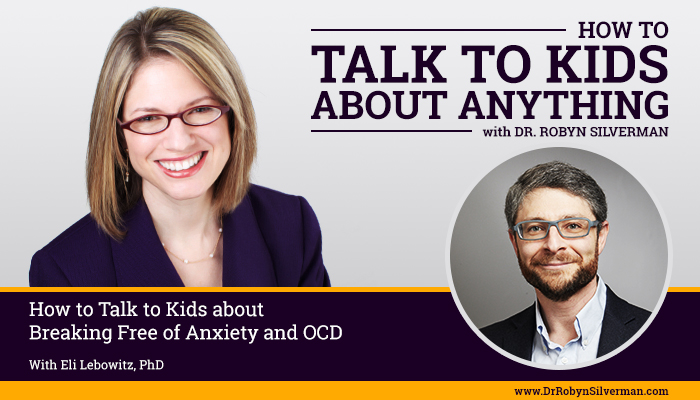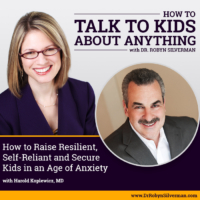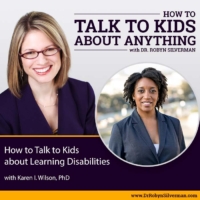Podcast: Play in new window | Download
Subscribe: Apple Podcasts | RSS | More
How to Talk to Kids about Breaking Free of Anxiety and OCD

This podcast will focus on how to talk to kids about anxiety and OCD. Dr. Robyn Silverman interviews Dr. Eli Lebowtiz about the key to helping kids cope with their anxious behavior—acceptance and confidence. This podcast provides many scripts and strategies for parents and educators.
It’s healthy and normal to become aware of possible threats and dangers around us so that we can be safe and make safe choices- however, in children with anxiety, they get stuck in continually imagining that something bad or dangerous will happen, and it feels just as if the bad thing were happening in real life. They are experiencing the feelings or anxiety as if they are indeed going to happen. They focus on what they truly believe are the negative outcomes that have a large likelihood of occurring and place high value on those negative outcomes—while at the same time, placing very low value and likelihood on positive outcomes that might occur from taking the risk and doing the thing that scares them.
Parenting an anxious child means facing constant challenges and questions: When should parents step in and help their children deal with those fears—or take away the likelihood of those fears by avoiding the thing that scares their child? How can parents foster independence while still supporting their children and acknowledging the anxiety? How can parents reduce the hold their child’s anxiety has on their entire family—and cope with the role they may be inadvertently playing in kowtowing to the anxiety while trying to help their child cope with it? And how do we talk to our children about anxiety- and how we can support them in living with it in a positive way?
For this conversation, I will be talking together with Professor Eli Lebowitz.
Professor Lebowitz studies and treats childhood and adolescent anxiety and is Director of the Program for Anxiety Disorders at the Yale University’s Child Study Center. His research focuses on the development, neurobiology, and treatment of anxiety and related disorders, with special emphasis on cross-generational and familial influences on these disorders. Dr. Lebowitz is the lead investigator on multiple funded research projects, and is the author of numerous research papers, books and chapters on childhood and adolescent anxiety. He is the father of three great boys. Dr. Lebowitz has a new book out called Breaking Free of Child Anxiety and OCD.
Important Messages:
- We all might have a picture in mind of what an anxious child looks like- cowering in corner, looking away, shy, inhibited. True for some! But not the description of all.
- Remember fight or flight. While some anxious children will “take flight” when scared, others will fight! Flight direction- fear. Other kids, fight direction- aggression, temper tantrums, irritability, rigidity- many other manifestations.
- Anxiety affects everything. There are four domains of body, thoughts, behaviors and feelings. All these areas change while we are going through anxiety. Many people think about the feelings of anxiety- fear- but they don’t think of the other feelings we have, like anger. It’s also the feelings we don’t have- like happy, curious, motivated and excited. Can look different in different children- must get curious and notice it- then the children can get the help that they need.
- Anxiety can look like a behavior problem. Home- Slammed doors, talking back, refusal to do something. School- the teacher who puts their hand on the shoulder of a child who looks distressed and then gets shoved in response or yelled at- that could trigger our own fight or flight. We can get anxious or angry in that moment. Could be anxiety- think it’s disciplinary issue but might not be!
- *School- absenteeism- thought it used to be truancy but BY FAR the child who is chronically absent from school is not suffering from an externalizing behavioral problem but an internal problem like anxiety or depression.
- Many people get the advice that when they see behavior problems- ignore it and it will go away. But you say in your book that “research on childhood anxiety problems shows that simply waiting for an anxiety problem to go away on its own doesn’t usually work” and that it can be “successfully addressed.” How do we address? Statistically- not helping an anxious child will likely lead to a more anxious child. BUT anxiety is one of the most treatable problems!
- If you put those things together- that anxiety it’s not likely to go away on it’s own and it’s highly treatable, you have a pretty good argument for getting treatment!
- Anxiety- medication, therapies. First- change your attitude towards anxiety.
- Anxiety system- alarm system. Designed to be unpleasant. (Then you will pay attention!) Just like alarm in house. We don’t have our smoke alarm play our favorite tune so we hang around an listen to it! We make it play an unpleasant sound so we think; ‘I have to turn that off. I have to get out of here or make it stop because this is really bothering me. And that’s how our anxiety system works as well. Because when we are faced with real dangers, we don’t want to stick around and see how it goes- we want to get ourselves out of that dangerous situation. But when our smoke alarm or our anxiety alarm is a little bit sensitive or miscalibrated (we’ve heard alarm when it wasn’t actually being stolen- too sensitive! Hae you ever heard a car alarm go off- yes! Have you heard it going off because it was being stolen- maybe not!). Our anxiety alarm is not perfect.
- This is a trap. We have to learn to change our attitude towards anxiety. If we are always trying to get away from feeling anxiety, we are dooming ourselves. And as parents, if we are setting a goal to remove anything that will lead to anxiety for our child (although our hearts are in the right place!) what are we teaching our children? That anxiety is awful and we have to stay away. Teaching child to avoid. To not feel safe and confident about dealing with anxiety.
- Change it to- “I can deal with anxiety! It sucks! I don’t feel comfortable. I don’t love it. But I’m going to be okay- and it’s going to go away. I’m going to be there. And the sun will still rise. It’s okay to be anxious sometimes.
- Model a supportive attitude- around anxiety. So important to do this for a child who is coping with anxiety.
- Supportive: (1) Accepting. You can’t be supportive if you trivialize it. Or are dismissive of it. Sometimes we do this in harsh ways like “don’t be a baby” and sometimes subtle “it’s not scary.” “I wish you weren’t scared.” Child is frightened! Says it’s wrong or not genuine. Say; “I get it! I see this is hard for you. I know this is scary for you.” You won’t make your child more anxious by acknowledging the fact that they are.” Validate the feeling- so that they don’t need turn it up a notch to convince you. “When we validate emotions they tend to get lower not more powerful.” (2) Show that you have confidence in them. Even if you don’t like it- they are still going to experience anxiety. You don’t want to teach a child; “you are going to have all this anxiety in your life and sadly, you can’t cope with it!” If you think about the child who was just diagnosed with asthma- you would never want to say; “it’s terrible that you were just diagnosed with asthma because you suck at asthma! You want to say- this sucks, it’s a challenge, but you can handle it. You are capable. We’re going to help you and you are going to be just fine. You are going to have a great life even if you have asthma.” Same with anxiety! Confidence means- you can handle it! “I know that you can handle it.”
- Things we might do that backfire- protection and demanding ways to respond. Protective: “It’s my job to make sure that you will be ok.” Things they say to their children and about their children. Your child is listening to what you say about them when you are on the phone talking to a friend or when you are at the doctor’s office. We are teaching our children all the time- not just when we attend. “My child can’t handle stress” is something that people say. But what are you saying? Learning: I can’t handle stress. My parents are very knowledgeable and know me best so I should listen to that. “My child goes to pieces.” “My child is fragile.” “My child is a worrier.” While true- but now defining child by his worrying. Instead of “My child is strong and can handle his worries.”
- You are the mirror that your child looks into to see who they are! True, in general. For example, if they try to be amusing but they look at you and just see that they are irritating you, then they will learn that they are an irritating and not so amusing person.
- Don’t have to lie- every child is funny sometimes. Sometimes they tell interesting stories. Not lying about anxiety- can handle it. Can handle it. Don ‘t rush to fix. Last time they had a tantrum. So we come to conclusion that they can’t handle it. But if you think about it, after the meltdown, they recovered. They were able to handle some of the discomfort.
- Demanding- when I give the message that they shouldn’t feel as they feel or should somehow magically pretend to feel different than they do.
- **Repelling story. Boy terrified to repel. Father is dangling off the cliff below telling him it’s fun. Boy was not having fun. Terrified. Father wasn’t conveying that this is hard for you- was communicating that this should be easy for you like it’s easy for me. It’s easy to be superman when your kid is small. But we also need to give the a bridge to see that they can also be strong (and brave).
- Just because YOU can do it and you don’t feel anxious or you have conquered the anxiety doesn’t mean that your child can do that in the moment. We are being demanding when this is the message that we don’t believe their experience or we are telling them they shouldn’t feel as they feel. Neither one is supportive. You can’t be supportive you are overly protective or overly demanding.
- Demanding can sound like; “just get a grip. Go ahead and do it already! Or “why can’t you be more like your sister who already did xyz?”
- INSTEAD: Supportive. Don’t have to be a master. Don’t have to be creative. Rely on recipe of acceptance and confidence. (1) First of all, I can see that you are really scared right now. Think of their inside feeling when the person they really care about- the person they admire acknowledges this feeling. The inside feeling shifts. I’m not just yelling rah, rah, rah, go, go, go, you can do it, you SEE their experience You see them. “I get that this is really frightening for you. (2) And I also know that you can handle this feeling. And if you want to give this a try- even a little try- I’m right there with you.” You’re not the impatient person waiting at the bottom of the mountain. You can be by their side.
- **Accommodations. Where research is focused now in anxiety treatment. All the different ways that parents are changing their behaviors so that the child doesn’t feel the anxiety. No parent wants their child to suffer. Even though accommodations might help the child with anxiety, they can be detrimental. This is a hard pill to swallow because we are all trying to just get through the day. We have other kids. We have to get to work. We have to get to school. We have to get to sleep. This is tough on parents. What we know- accommodations have the kids get stuck.
- Example. Separation anxiety. Scared when you are not nearby. So maybe you accommodate. You don’t go out at night. You sleep next time them. You call ahead and have the the family put the dog away. Conveys to the child- the only way that you can feel okay in new situations is for us to ensure that this thing that makes you uncomfortable will not be around.
- Worried- lots of questions. You answer- them – that’s accommodation. Social anxiety- you speak in place of them. Not bad behavior. This is not caused by the parent. This is how we respond to the behavior- not how we cause it. We don’t want to validate the fear!
- We can get trapped into this cycle of accommodation. We send the message that this is a problem, that they can’t handle it and we need to step in.
- Story- burglars- parent got the best lock because child was afraid of buglars- and by getting the lock, validates the fear.
- Reinforcing that anxiety is dangerous to me and these worries I have about the real world are valid. (*Do you want to validate the feeling or the fear??)
- Being supportive AND systematically reduce accommodations (gradual, supportive way) do these 2 things together- treat anxiety.
- SPACE- Supportive Parenting for Anxious Childhood Emotions. More supportive and less accommodating. These 2 things- can overcome anxiety and OCD. Map it out.
- Can’t just say “no more accommodations.” Has to be done slowly. Can’t strip it all away at once. Not a slogan. Step by step. Think over the entire day. Texting my child during the day? Getting up early? Changing my day? Changing my sleep? Night time plans? Write it down in non judgmental way.** What are the things I do differently because this child is anxious? How often do I do them? Accommodation map. Pick oner thing. Things that happen frequently. Practice it.
- Don’t do it by surprise. Let them know. In supportive way. “I am going to be doing this differently. Because I care about you and I realized that I haven’t been helping you in the best way. I’m going to do this differently because I love you- and I know it will be hard but I also know that you can handle it.
- Resistant? What’s the next step? Through this process, you’ll never demanding your child to do anything. Because the thing you chose to focus on was reallt about YOUR behavior. They might not change right away. May lag. See you reduce. Hear your words.
- Child won’t order at restaurant. Target. Doesn’t mean child will speak to waiter right away. If you do it right- you make the plan for your behavior, not theirs. You don’t have a plan for their behavior. We don’t get to decide. I’m not going to order for them. Focus on change in YOU. I know this is hard for you- but also know you can handle it. Child might not order- might get upset- but that doesn’t mean you have to as well. Shifting. Point. Finding ways to cope. Smaller step. I can stay calm. Benchmarks to success might be different than you anticipated. Might not climb down the mountain or order to food or touch the spider- but incremental. Still progress.
- Don’t want to punish the kid for being anxious. Not a misbehavior.
- Stick to changes– will be changes in child’s behavior.
- Key to breaking free- acceptance and confidence.
- Moments- get out of bed due to monsters- opportunities. “I am someone who can handle anxiety.” See as problems- miss opportunity. Just like when child is learning to walk. Watching and learning.
Notable Quotables:
- “I like to remind parents of the popular phrase, ‘fight or flight.’ So often we forget that half of that phrase is ‘flight.’ For some children, anxiety is going to drive them more in the flight direction with feelings of fear. In other children, it might drive them more to the fight side of it—aggression, anger, irritability, temper tantrums, rigidity. We need to broaden our view of what anxious child will look like.”
- “When we are anxious, our body, thoughts, behaviors and feeling change. So often we think of the ‘feelings part’ only as fear but it’s also those anger feelings and it’s also those feelings we don’t have when we are anxious like feeling happy, excited, motivated, or curious. Anxiety can look really different in different children so getting really good at detecting it and noticing it means we can get so much better at getting the help that children need.”
- “We used to think of absenteeism from school as primarily truancy- the kid who wants to hang out at the mall and play with friends or just play video games– but actually, by far, it’s much more likely that a child who is chronically absent from school is actually suffering not from one of those externalizing behavior problems but from an internalizing problem like anxiety or depression.
- “Anxiety is one of the most treatable childhood problems. We wish we had effective treatments for so many other problems in mental health that even came near the level of the efficacy of our treatments for anxiety problems. It means that the world is full of children who used to have an anxiety disorder and don’t today.”
- “The natural response towards feeling anxious is to want to not feel anxious.”
- “On a basic level, anxiety is our alarm system. It’s designed to be unpleasant. Like the smoke alarm in our house- we don’t have it play our favorite tune so we hang around an listen to it! We make it play an unpleasant sound so we think; ‘I have to turn that off. I have to get out of here or make it stop because this is really bothering me. And that’s how our anxiety system works as well. Because when we are faced with real dangers, we don’t want to stick around and see how it goes- we want to get ourselves out of that dangerous situation.”
- “The biggest gift a parent can give to a child who is vulnerable to anxiety is helping them know that they can cope with it and still be okay.”
- “You can’t be supportive of your anxious child is you are dismissive of or trivialize their anxiety.”
- “You won’t make your child more anxious by acknowledging the fact that they are.”
- “I like to say to parents; ‘you are the mirror that your child is looking into and they are seeing who they are.’”
- “Children are a lot more resilient and capable than we sometimes give them credit for.”
- “Don’t want to punish the kid for being anxious—it’s not a misbehavior.”
- “The key to breaking free of child anxiety and OCD is acceptance and confidence.”
Resources:
SPACEtreatment.net
Breaking Free of Anxiety and OCD https://www.amazon.com/Breaking-Free-Child-Anxiety-Scientifically/dp/0190883529







